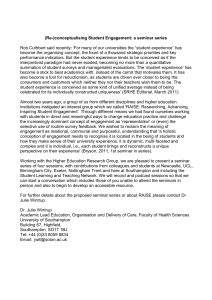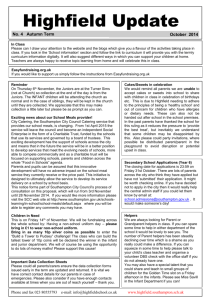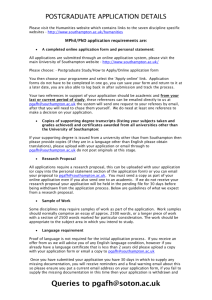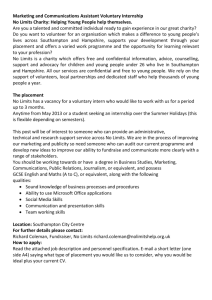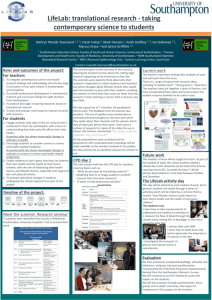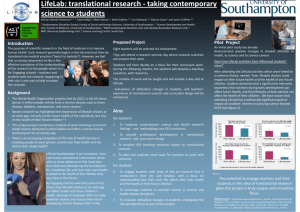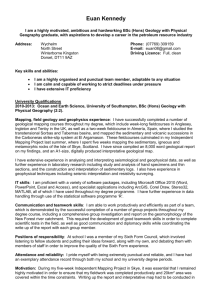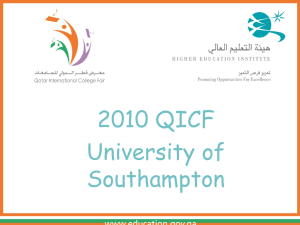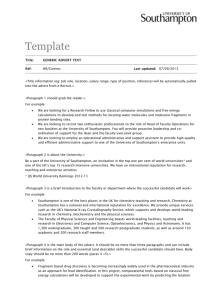log book - E-Learning Research Methods
advertisement
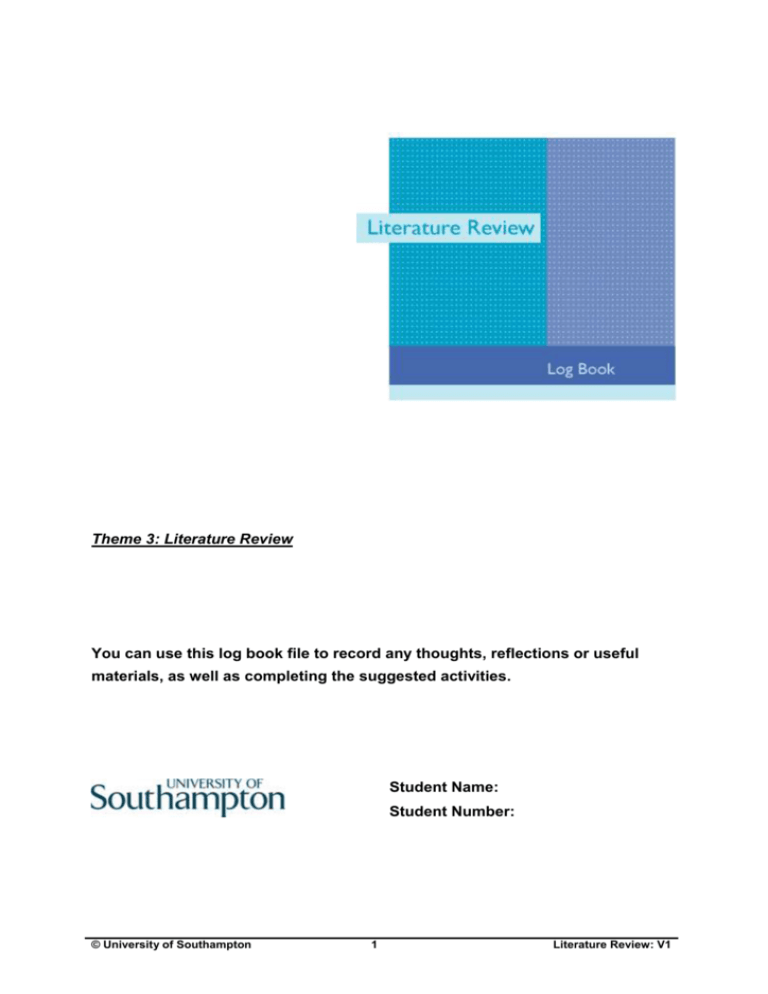
Theme 3: Literature Review You can use this log book file to record any thoughts, reflections or useful materials, as well as completing the suggested activities. Student Name: Student Number: © University of Southampton 1 Literature Review: V1 ACTIVITY 1: How do you search for material now? Consider the experience and skills you have gained during your previous programmes of study in: gathering material from a range of different sources; judging the relevance of material; knowing how to reference the material in your work. Task 1 Create a list of the ways in which you have searched in the past to find material what tools and services have you used to do this searching? For example, a library catalogue or a bibliographic database. Order the list according to the frequency of your use of the tools or services. List of the tools and services you have used to find material. 1. 2. 3. 4. 5. Task 2 Do you use reading lists provided by your tutors and lecturers? Yes/No If so, how do you locate these items in a Library? How you search for items in a Library © University of Southampton 2 Literature Review: V1 Task 3 In what ways have you then recorded information about the material you have found - have you created hand-written lists on paper, databases on your PC, or developed lists in word-processed assignments? Your ways of keeping a record of the material you used in your writing Task 4 Have you ever had to spend time searching for material of which you have only a dim recollection but are unable to remember precise details? If you did manage to track down the details eventually, how long did it take you to do so? How do you approach verifying the exact details (How do you go about finding the material?) Your ways of verifying the details of material Time spent on tracking Your ways of finding full details of material Now, reflect on the answers you have given for the tasks in Activity 1 and consider your confidence in searching for material and recording the details by completing Activity 2. © University of Southampton 3 Literature Review: V1 ACTIVITY 2: How confident are you when searching for material? Scale your confidence level for the statements below (Not at all confident 1 2 3 4 5 Very confident) 1. I know how to search for material using bibliographic databases. 2. I know how to generate my own search terms. 3. I know how to search for a range of different forms of literature, e.g. books, periodical articles, websites etc. 4. I know how to identify appropriate, academic material. 5. I know how to judge the relevance and accuracy of material for my research. 6. I know how to record and manage references accurately and consistently. 7. I understand the concept of critical appraisal and know how to undertake it. 8. I understand the concept of plagiarism and know how it relates to my research. Activities 1 and 2 have encouraged you to examine your skill and confidence levels in searching for material and keeping a record of the details of material you found/used in your writing. Now, by selecting statements in Activity 3, think about how you approach reviewing material? © University of Southampton 4 Literature Review: V1 ACTIVITY 3: How do you review material? Read the whole without making notes. Read everything thoroughly, making notes. Summarise as you read. Record the full bibliographic details alongside your own summary. Read the abstract or summary provided and forget about the full text. Others: Please describe. In the following sections of this theme you can improve your skills and understanding in this area of your research work. To get started with this, go to the website and work through the material provided. © University of Southampton 5 Literature Review: V1 ACTIVITY 4: Search for known terms To complete the tasks below, go through the steps outlined in the animation, or read the instructions provided on the webpage ‘Searching for known terms’ in Core Theme 3, associated with Activity 4. Task 1: By clicking on the General Search button at the top of the screen on your search engine and repeating the stages in this search process; retrieve the full bibliographic records for the following 2 references: Article 2: McInnerney, J.M. & Roberts, T.S. (2004). Online learning: social interaction and the creation of a sense of community. Educational technology and society, 7 (3), 73-81. Click on the General Search button, clear the search terms you used simply by clicking on the clear button and then type in your new search terms to retrieve this reference. You can now start to explore the ways in which you can save a copy of the information. Over on the right-hand side of the screen you can see buttons which enable you to email a copy of the information to yourself, to save a copy to disk or simply to print a copy for your own use. If you want to extract any records from the Web of Science databases, you must add them to a Marked List. This enables you later, to print, save, e-mail, or export records from the Marked Records screen. You can add records to a Marked List either from any summary list or from the full record screen. Click the Add to Marked List button to add records to your Marked List. To go to your Marked List, click on the Marked List button in the toolbar at the top of the screen. Adding this record to a marked list enables you to start to generate a list of references drawn possibly from different searches which you can save later for use as references to develop your ideas around a specific subject or assignment you are working on. Begin to develop a list of references which you can later email to yourself. © University of Southampton 6 Literature Review: V1 And now search in the same way for this paper: Article 3: Hannan, A. (2005). Innovating in higher education: contexts for change in learning technology. British Journal of Educational Technology, 36 (6), 975-985. For all of these articles, you can check whether or not the Library provides access to the full text, and which routes you need to use to gain access by clicking on the TDNet logo, and following the links through to the full text of the articles where they are available electronically. Follow the links from Web of Science via TDNet to link to the electronic full text for each of these references. Click on the words to the right of the TDNet icon and then click on the link for the service provider. Work between the windows that open on your screen to get to the individual paper you need. Task 2 Save a copy of the PDF version of the full text you searched for and found to your own computer. Tips When you are working with electronic copies of journal articles and other materials you need to be aware of copyright regulations as well as the licensing terms that apply to access and use of the services and resources. For more information, link to: http://www.soton.ac.uk/library/about/regulations/ejournals.html. Task 3 Choose another bibliographic database from the library website and search for the same three journal articles. 1. What database did you choose for your search? 2. Did the database include the articles? © University of Southampton Yes 7 No. Literature Review: V1 3. How did you search for them? Was your search the same as in the Web of Science? Yes No. If the answer is no, describe any differences you found between the databases used. © University of Southampton 8 Literature Review: V1 ACTIVITY 5: Search for other types of materials using sources available at the University of Southampton Use a different source (WebCat, Oceanis, or another database) available via the University of Southampton Libraries to search for references to a range of forms of literature. Task 1 Find four different types of material - a monograph, an edited book, a thesis, and proceedings of a conference. Write an example of each type in the table below. Forms of literature searched and found Source Bibliographic details Monograph Edited Book Thesis Proceedings of Conference You can do this by using your own search terms or by following the tips in this demonstration associated with Activity 5 on the ‘Searching for other forms’ website in Core Theme 3: © University of Southampton 9 Literature Review: V1 ACTIVITY 6: Explore your subject page on the Library website The Library website provides access to an increasing array of electronic resources via the subject pages, as well as via the individual service providers and publishers which host specific resources. Task 1 Go to the Library website. You need to explore the Library webpage provided to support your own academic subject. List four key resources which are presented to support your programme of study in the box provided below. The list should include at least one of the following: 1. A subject portal 2. A bibliographic database 3. An electronic journal title 4. A service which supports current awareness and keeping up-to-date with articles being published in your subject area. Four key resources which support your programme of study 1. 2. 3. 4. © University of Southampton 10 Literature Review: V1 ACTIVITY 7: Identify the criteria for evaluating the quality of websites Task 1 Identify the criteria you have used for evaluating the quality of websites during your previous programme of study. a) Your previous programme of study: b) Web resources evaluation criteria you have used: 1. 2. 3. 4. 5. © University of Southampton 11 Literature Review: V1 ACTIVITY 8: Identifying the criteria for evaluating the quality of web sites for your programme of study Task 1 Identify the criteria you intend to use for evaluating the quality of websites for your programme of study. a) Your current programme of study: b) Web resources evaluation criteria you intend to use: 1. 2. 3. 4. 5. c) Are these criteria different from those you listed in Task 1, Activity 7? Yes No d) If yes, in what ways do they differ? © University of Southampton 12 Literature Review: V1 Task 2 Now explore websites in your discipline and identify three websites: one of high quality, one of moderate and one of poor quality. Give reasons for your answers. 1. High quality website and reasons. a) Web address: b) Reasons: 2. Moderate quality website and reasons. a) Web address: b) Reasons: 3. Poor quality website and reasons a) Web address: b) Reasons: © University of Southampton 13 Literature Review: V1 ACTIVITY 9: Critical evaluation of qualitative research Task 1: a) Download the CASP qualitatitve research checklist (http://www.phru.nhs.uk/Doc_Links/Qualitative%20Appraisal%20Tool.pdf) and save it on your computer. b) Choose ONE of the following resources and use the CASP checklist to evaluate it. You should be able to access these resources online if you are using the University of Southampton log-in. 1. Hantikainen V. & Kappeli S. (2000) Using restraint with nursing home residents: a qualitative study of nursing staff perceptions and decision-making (http://www.blackwell-synergy.com/doi/full/10.1046/j.1365-2648.2000.01590.x) Journal of Advanced Nursing 32(5), 1196-1205. 2. Hussin, H. (2006) Dimensions of Questioning: A Qualitative Study of Current Classroom Practice in Malaysia (http://www-writing.berkeley.edu/TESLEJ/ej38/a3.pdf). TESL-EJ 10 (2). 3. Punch, S. (2001) Household Division of Labour: Generation, Gender, Age, Birth Order and Sibling Composition (http://wes.sagepub.com/cgi/content/abstract/15/4/803). Work, Employment & Society, Vol. 15, No. 4, 803-823. c) Write an introduction to the resource and the results of evaluating it with the checklist in your Literature Review log book. i) Introduction to the resource © University of Southampton 14 Literature Review: V1 ii) Results of evaluating it with the checklist Task 2: Now find a paper in your own field and apply the critical evaluation process to it. If your paper is not based on a qualitative analysis you may find a different CASP checklist more useful or you might like to find more appropriate tools or guidelines. Some other examples are: © University of Southampton 15 Literature Review: V1 Science & Engineering: How to Read an Engineering Research Paper (http://www.cs.ucsd.edu/~wgg/CSE210/howtoread.html) by William G. Griswold CSE, UC San Diego Types of research in computing science software engineering and artificial intelligence (http://www.cs.bham.ac.uk/~axs/misc/cs-research.html) by Aaron Sloman, University of Birmingham Arts & Humanities: What is critical reading? (http://www.criticalreading.com/critical_reading.htm) by Dan Kurland. i) Introduction to the resource ii) Results of evaluating it with the checklist © University of Southampton 16 Literature Review: V1 © University of Southampton 17 Literature Review: V1 ACTIVITY 10: Identifying and developing search terms Earlier you searched for a reference in the Web of Science: Guzzo, R.A. & Dickson, M.W. (1996) Teams in organizations: recent research on performance and effectiveness, Annual review of psychology 47, 307-338 Task 1: a) Find the record again and look beneath the abstract of the article in the full reference version of the record. You will see 2 field labels immediately beneath the abstract: Author keywords and keywords plus. In Web of Science, author keywords are included in records of articles from 1991 onwards. "Keywords Plus" presents are words or phrases that appear frequently in the title field of an article's references, but not necessarily in the title of the article nor in the author keywords. These terms, used in conjunction with the abstract as well as the bibliographic details of the reference, help you to form a more complete understanding of the subject and focus of an article. In addition, these same terms can be used to develop searches in a specific subject area for new material. b) Analyse the concept terms used in the article title, abstract, author keywords and keywords plus for the Guzzo and Dickson article. c) Think about the relationship between these terms and the article itself. d) Now, produce a table of terms which you could use that is related to your own field of interest. e) List the terms in the table below. Terms identified and developed for a new search © University of Southampton 18 Literature Review: V1 ACTIVITY 11: Combining your searches using 'Search History' Use the terms you have listed to undertake, at least, 3 separate searches in Web of Science that will retrieve material related to your area of research. When you have searched individually on each separate term, link to the Search history button to display all of the searches you have undertaken in the course of the session you are currently logged into. In Search history, you can see an additional column and tick boxes to the left of the search sets. Combine the searches using the connector that will enable you to retrieve the references most relevant to you. Remember, you will still need to review and analyse the list of references to differentiate between those which are of potential interest to you and those that are not. Save the list of references, with key terms used to retrieve them in your log book. © University of Southampton 19 Literature Review: V1 ACTIVITY 12: Critical appraisal of a online research publications Scenario: A good friend of yours is a heavy smoker. You are planning to go traveling with her and know that this will only be possible if she can save up enough money to cover the cost of the trip. You are determined to help your friend stop smoking and start saving. Your friend is prepared to consider using nicotine replacement therapy and asks you to find some information that will persuade her of the efficacy of this approach. Task 1 a) Look at these 4 online references: Reference 1: Smoking (quitting). (http://www.nhs.uk/Conditions/Smoking(quitting)/Pages/Introduction.aspx?r=1&rtitle=Smoking+(quitting)++Introduction) NHS Direct Online Health Encyclopaedia, 2006.. Reference 2: WhyQuit.com (http://whyquit.com/). WhyQuit.com, 2006. Reference 3: Nicorette (http://www.nicorette.com/), GlaxoSmithKline, 2006. Reference 4: Varenicline for smoking cessation (http://www.nice.org.uk/TA123). National Institute for Health and Clinical Effectiveness, 2006. b) Now read the extract from reference 5 provided below. Reference 5: Silagy, C. et al. (2001) Nicotine replacement therapy for smoking cessation (Cochrane Review). In: The Cochrane Library, 2, 2001. Oxford: Update Software. Extract: 'Main results : We identified one hundred trials; of the 88 with a non NRT control group, 48 trials were of nicotine gum, 30 of transdermal nicotine patch, four of intranasal nicotine spray, four of inhaled nicotine and two of nicotine sublingual tablet. Four trials compared combinations of two forms of nicotine therapy with one form alone. The odds ratio for abstinence with NRT compared to control was 1.71 (95% confidence interval 1.60 to 1.82). The odds ratios for the different forms of NRT were 1.63 for gum, 1.73 for patches, 2.27 for nasal spray, 2.08 for inhaled nicotine and 1.73 for nicotine sublingual tablet. Reviewers' conclusions: All of the commercially © University of Southampton 20 Literature Review: V1 available forms of NRT (nicotine gum, transdermal patch, the nicotine nasal spray, nicotine inhaler and nicotine sublingual tablets) are effective as part of a strategy to promote smoking cessation. They increase quit rates approximately 1.5 to 2 fold, regardless of setting.' c) Answer the following questions: a) Do you think that all of these resources are providing similar kinds of information and research output? Yes No b) If not, why not? Provide reasons. © University of Southampton 21 Literature Review: V1 ACTIVITY 13 Critical evaluation of an academic publication Scenario: Someone you know has been looking for articles about the 'good and bad aspects of GM foods' in the UK for a project he is carrying out for his geography course. This is one of the articles he has retrieved: Oda, L.M. and Soares, B.E.C. (2000). Genetically modified food: economic aspects and public acceptance in Brazil. Trends in Biotechnology, 1, 188-190. Task 1 a) State the topic that he is trying to find material on. Search topic area: Task 2 a) Look at the reference he has found. b) Write down 2 reasons that you might suggest to your friend that this item is not strictly relevant to his need. Your reasons: 1. 2. © University of Southampton 22 Literature Review: V1 ACTIVITY 14: Critically evaluating materials and identifying objective information Task 1 a) Visit the following websites and decide whether these sources are likely to provide objective information: 1. Climate Change Briefing Sheets (http://www.airportwatch.org.uk/briefingsheets/climatechange/index.php). Airportwatch, 2004. i) Provides objective information: Yes No ii) Your reasons: 2. London Heathrow Airport (http://www.foe.co.uk/campaigns/climate/case_studies/heathrow.html). Friends of the Earth i) Provides objective information: Yes No ii)Your reason: 3. Climate Change (http://www.baa.com/portal/controller/dispatcher.jsp?CiID=16f5fe1037c6f110VgnVC M10000036821c0a____&ChID=368410078a8be110VgnVCM10000036821c0a____ &Ct=B2C_CT_GENERAL&CtID=448c6a4c7f1b0010VgnVCM200000357e120a____ &ChPath=Home^BAA+Airports^Corporate+responsibility^Issues+and+our+approach ^Climate+change). British Aviation Authority, 2006. i) Provides objective information: Yes No ii) Your reason: © University of Southampton 23 Literature Review: V1 4. Sustainable aviation (http://www.nats.co.uk/text/51/sustainable_aviation.html). National Air Traffic Services Limited, 2006 [Accessed 29 June 2006] i) Provides objective information: Yes No Yes No ii) Your reason: 5. Tyndall Centre for Climate Change Research (http://www.tyndall.ac.uk/index.shtml). i) Provides objective information: ii) Your reason: Task 2 The following articles are available in full text, electronically via the University Library. a) Locate the full text, read the articles and comment on each of them from the point of view of reliability and quality. Tip When you read the articles, use the evaluation criteria and questions you identified through reading ‘Approaches to your literature review’ and Activities 10, 11 and 12). 1. Williams, V and Noland, R.B. (2005) Variability of contrail formation conditions and the implications for policies to reduce the climate impacts of aviation. Transportation research part D: Transport and environment 10 (4), 269-280. i) Provides objective information: Yes No ii) Your reason: 2. Gehring, U et al (2002) Traffic-related air pollution and respiratory health during the first 2 years of life. European Respiratory Journal 19, 690-698. © University of Southampton 24 Literature Review: V1 i) Provides objective information: Yes No ii) Your reason: 3. Stuber, N. et al (2006). The importance of the diurnal and annual cycle of air traffic for contrail radiative forcing. Nature, 441 (7095), 864-867. i) Provides objective information: Yes No ii) Your reason: Task 3: a) Write a further critical review of the resource you evaluated, taking into account everything you have learned from this theme. b) Write a conclusion about the quality of the resource. Further critical review of the resources you evaluated: Your conclusion of the quality of the resource: © University of Southampton 25 Literature Review: V1 © University of Southampton 26 Literature Review: V1 ACTIVITY 15: select from the list, the elements that are required in a reference for a periodical article. 1. Name(s) of the author(s) Required/ Not required. 2. Publisher of the periodical: Required/ Not required. 3. Date of publication: Required/ Not required. 4. Abstract: Required/ Not required. 5. Title of the article: Required/ Not required. 6. Page numbers for the article: Required/ Not required. © University of Southampton 27 Literature Review: V1 ACTIVITY 16: Recording your references Task 1: a) Use the information below to create a book reference. Chapter used: Chapter 2 Literature Search Book title: Research Methods Publisher: Winchester: University of Southampton Editors: Anna Barney and Sunhea Choi Chapter author: Debra Morris Publication date: July 2007 Page numbers 35-48 b) Record the book reference here: Task 2: a) Use the information below to create a journal reference. Article title: How to be an excellent researcher Journal title: Journal of Research Methods Publisher: Southampton: Solent Scientific Author: Debra Morris Publication date: July 2007 Volume number: 66 Issue: 13 Page number: 25 - 68 b) Record the book reference here: © University of Southampton 28 Literature Review: V1 ACTIVITY 17: Producing a list of references Task 1 By following the instructions given below identify the 6 references with which you will work and present them in the appropriate formatted style. If you want to view a demonstration for searching for the references using search options, click the Flash animation on Core Theme 3 website, ‘Listing references’. a) Go to Web of Science via the library website (if you cannot remember how to access Web of Science, go back to Activity 4). b) Carry out the following in General search: Setting the search limit o Set these limits: English language only o Dates: from 2002-2006 Terms to search on (three separate searches): o Issues o research - restrict to title only o knowledge - restrict to title only c). Combine these 3 searches in the Search history function with the 'and' operator. d). From the list of references you now have, select: Pullman and Hodgkinson, 2006 - article Schrag et al 2003 - editorial Scruggs and Mastropieri, 2003 - book review Surapaneni et al, 2002 - editorial - conference Alavi and Leidner, 2001 - review Bertino and Damiani, 2005 - article e). Using only these 6 items from the list you have on Web of Science, produce a list of references using the Harvard style of referencing. Then check the model answer given on the associated webpage for Activity 16. List of the references in Harvard style of referencing: © University of Southampton 29 Literature Review: V1 1. 2. 3. 4 5. 6. Task 2: Check the model answer on the webpage with yours and if there are significant differences, discuss them with colleagues or your tutor. Correct them as appropriate. Task 3: In your own subject area, select 2 significant periodical titles (agree these with your tutor) and identify the reference format that these publications use. Provide an example here: Task 4: © University of Southampton 30 Literature Review: V1 Ensure that you know what referencing format is required in the thesis you will be examined on for your degree at The University of Southampton. This style may vary from academic School to academic School. Provide some examples here: © University of Southampton 31 Literature Review: V1 ACTIVITY 18: Test your understanding of academic integrity Task 1: State whether the following statements are true or false. 1. A citation is the full bibliographic information included in the list at the end of the text and the reference is the brief information you include within the text. True False 2. I am presenting my own ideas in this work. I do not need to reference them. True False 3. You have discovered a useful website while searching on the Worldwide web. Having established its validity, authority and rigour, you have decided to use the ideas presented but do not need to reference it because it is freely available on the web. True False 4. A good way to impress my supervisor and because I enjoy a challenge, I am going to develop my own referencing system. True False 5. The list of references at the end of my written piece should only include the citations I have included within the text. True False © University of Southampton 32 Literature Review: V1 ACTIVITY 19: Importing references from Web of Science to Reference Manager In Activity 17 you searched for, and identified the 6 references listed below, and presented them in the required formatted style - Harvard. TASK 1: a) In this activity, you need to import these 6 references into one of the bibliographic software packages, Reference Manager. Follow the instructions given below. 1. Go to Web of Science via the library website. 2. Carry out the following in General search: Setting the search limit o Set these limits: English language only o Dates: from 2002-2006 Terms to search on (three separate searches): o Issues o Research - restrict to title only o Knowledge - restrict to title only 3. Combine these 3 searches in the Search history function with the operator 'and'. 4. From the list of references you now have, select: Pullman and Hodgkinson, 2006 - article Schrag et al 2003 - editorial Scruggs and Mastropieri, 2003 - book review Surapaneni et al, 2002 - editorial - conference Alavi and Leidner, 2001 - review Bertino and Damiani, 2005 - article © University of Southampton 33 Literature Review: V1 5. Import these 6 references into Reference Manager as a separate database. If you do not know how to use Reference Manager in this way, play the animation presented on the webpage associated with Activity 19 in Core Theme 3. © University of Southampton 34 Literature Review: V1 Activity 20: How do you intend to search for information now? Task 1 Create a list of the ways in which you intend to search for material. List of the ways you intend to search for material 1. 2. 3. 4. 5. Compare your responses here with those in Activity 1 Task 1 in your log book. Are there differences? ( Yes No) If yes, what are the changes? Changes What in this theme prompted the changes? Reflect on your learning experience in this theme and think about how they happened; for example, improving your understanding of using bibliographic databases, searching terms, retrieving references, judging relevance, appraising materials and managing references, etc. Stimuli for the changes © University of Southampton 35 Literature Review: V1 Task 2 How will you use the Library Catalogue to search for materials? Compare this response with Activity 1 Task 2. Are there any changes? ( No) If yes, what are they? Yes Changes What in this theme prompted the changes? Reflect on your learning experience in this theme and think about how they happened. Stimuli for the changes If the items are not held in the University Library, how will you get access to them? How you will obtain items not held in the Library Discuss your response with your group members and explore better ways of obtaining items outside the University. Task 3 How will you record and manage the references and materials you have found? © University of Southampton 36 Literature Review: V1 Compare this response with Activity 1 Task 3. Are there any changes? ( No) If yes, what are they? Yes Changes What in this theme prompted the changes? Reflect on your learning experience in this theme and think about how they happened. Stimuli for the changes Task 4 If there are any contradictions between your references, how will you verify the exact details? Compare this response with Activity 1 Task 4. Are there any changes? ( No) If yes, what are they? Yes Changes What in this theme prompted the changes? Reflect on your learning experience in this theme and think about how they happened. Stimuli for the changes Task 5 How will you appraise material in future? © University of Southampton 37 Literature Review: V1 Compare this response with Activity 3. Are there any changes? ( yes, what are they? Yes No) If Changes What in this theme prompted the changes? Reflect on your learning experience in this theme and think about how they happened. Stimuli for the changes Task 6 Share your responses in Tasks 1 to 5 with your group members. Upload your log book to your tutor. © University of Southampton 38 Literature Review: V1 Activity 21: Evaluate your confidence about completing the literature review by rating the statements below. Scale your confidence level for the statements below (Not at all confident 1 2 3 4 5 Very confident) 1. I know how to search for material using bibliographic databases. 2. I know how to generate my own search terms. 3. I know how to search for a range of different forms of literature, eg journal articles, books, etc. 4. I know how to identify appropriate, academic material. 5. I know how to judge the relevance and accuracy of material for my research. 6. I know how to record and manage references accurately and consistently. 7. I understand the concept of critical appraisal and know how to undertake it. 8. I understand the concept of plagiarism and know how it relates to my research. Compare this response with Activity 2. If you now rate your confidence level number the same as or lower than in Activity 2, then revisit the relevant content and try the activities again. Also, you may discuss the areas you consider lacking with your group members, other class members and tutor. © University of Southampton 39 Literature Review: V1
